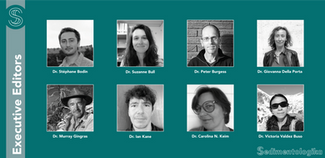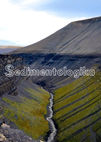
Camille Thomas
LATEST COMMUNICATIONS
Dead Sea
Paper published in Geochemistry, Geophysics, Geosystems : Combined Genomic and Imaging Techniques Show Intense Arsenic Enrichment Caused by Detoxification in a Microbial Mat of the Dead Sea Shore
This paper shows how microbial mats can store metals and accumulate them to super high concentrations, potentially leading to unique biosignatures in the geological record. It opens questions for bioremediation and early life research, and provides also a set of tools to investigate geobiological features from extreme environments (here the Dead Sea sinkhole system). I have published a thread on X, that can be found here.


Sedimentologika : a new Diamond Open Access scientific journal in the field of sedimentology
Sedimentologika is a community-driven initiative aiming to create a place where people can publish their research and access scientific studies on all types of sedimentary processes, methods, deposits, and environments, across all spatial and temporal scales, on Earth or any other planetary body, for free. The published material is free to share, since the authors retain the copyright. Sedimentologika is driven by the community for the community and is part of a broader DOA movement in geosciences. Sedimentologika aspires to provide direct and equal access to science to all citizens, scientists, and institutions all over the globe. This journal is defined by Open Science principles to promote ethical dissemination of science and knowledge, following high equality, diversity, and inclusion standards. You can look at the website and submit your work here : www.sedimentologika.org, and read the introductory paper describing the initiative here : Thomas et al., 2023
Lake Ohrid
Paper published in Microorganisms: Weak Influence of Paleoenvironmental Conditions on the Subsurface Biosphere of Lake Ohrid over the Last 515 ka
Within the Lake Ohrid ICDP Project (SCOPSCO), we investigated the microbial community of the deep sediments of the oldest lake in Europe using 16S rRNA gene sequences. The subsurface biosphere in lakes has been shown to retain signals of paleoclimatic and paleoenvironmental changes. We found weak evidence of such signal in Lake Ohrid, but important influence of terrestrial inputs to the lake and presence of clades adapted to low-energy environments. Read the article in open access here.

Dead Sea
Paper published in Geology : Recycling of archaeal biomass in the deep Dead Sea sediment
In collaboration with the organic geochemistry lab of the University of Lyon, we have identified unique isoprenoid wax esters in the most extreme facies of the Dead Sea sediments. They are the proof of a unique strategy used likely by Bacteria in the Dead Sea subsurface. By integrating compounds derived from the membrane of better adapted halophilic Archaea, they create carbon stocks and water, likely allowing their survival in this extreme environment. Read the article in open access here.

Dead Sea
Recycling of archaeal biomass in the deep Dead Sea sediment
In collaboration with French cartoonist Tommy Dessine, we created this cartoon to describe our recent findings in the deep Dead Sea sediments.
You can also view it in French on Tommy's website. Enjoy !
Dead Sea
New paper out : Fluid inclusions from the deep Dead Sea sediment provide new insights on Holocene extreme microbial life
We managed to extract fossil DNA from fluid inclusions of halite dated from the Holocene and recovered from the Dead Sea Deep Drilling Project.
lThey provide information on the paleobiology of the Dead Sea during the Quaternary. Read the article published in Quaternary Science Reviews here.










































